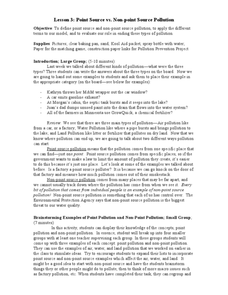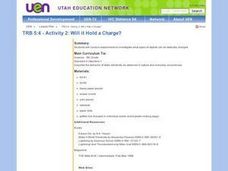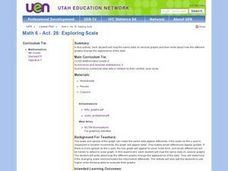Curated OER
Point Source vs. Non-point Source Pollution
Students define and differentiate between point source and non-point source pollution. Students discuss various types of pollution including air, water and land pollution, analyze demonstrations and complete a worksheet.
Curated OER
Ground Beef Experiment
Students compare the difference in the amount of fat and its flavor, by pan frying ground beef patties between three different kinds of ground beef - regular, lean and extra lean with different prices. They study basic information about...
Curated OER
Lighting
Students participate in a lecture in which they are introduced to the different types of lighting and lighting fixtures. Individually, they are given a floor plan of a house and create a lighting plan for it by placing symbols for each...
Curated OER
A Magnetic Personality
Fifth graders experiment to discover how many paper clips different types of magnets can pick up. They make predictions, carry out the experiment and collate the data.
Curated OER
Searching the THC Website
Learners use the internet to validate different websites. They examine the Texas Historical Commission's website and complete a question and answer section. They discuss the information they gathered with the class.
Curated OER
FDR's Fireside Chat on the Purposes and Foundations of the Recovery Program
Students discuss how they get information on important events or activities that occur in the national government today. They evaluate the New Deal, utilizing document analysis worksheets imbedded in this plan.
Curated OER
ADULT ESOL LESSON PLAN--Level 5--Telephone Communication
Students, after reviewing/defining an extensive list of vocabulary terms on the board, examine/identify a variety of resources found in telephone directories (maps, government agencies, coupons, customer guide section, emergency numbers,...
Curated OER
Representing Our Nation
Students use pennies to illustrate how our states are represented in Congress. This lesson is to be implemented during a unit covering the branches of United States government.
Curated OER
Comparing Apples and Oranges
Fifth graders, in groups, examine different types of apples and how they are different. They also taste the differences of each apple. They use this lesson to explore how to make observations.
Curated OER
Michigan Court System (Part 1) (Middle School)
Students identify the courts that make up the Michigan judicial system. They explore the responsibility of each court and diagram how cases move to the Supreme Court. They compare and contrast the different types of courts.
Curated OER
How to Protect Your Money
Learners review the basics of investing. They discuss saving strategies and investing fundamentals. Afterward, they consider a scenario from different investment perspectives.
Curated OER
OaxacaTurtles
Students identify types of turtles off the coast of Oaxaca. They become acquainted with the Mexican Turtle Center. They create a project (mural, map, panel discussion, logo/design) to communicate researched information.
Curated OER
How Many? How Far? How Thick?
Fifth graders examine the role of magnetism and electricity. In groups, they are given different types of magnets and discover how the magnetic force differs for each one. They measure the amount of distance a paper clip moves toward...
Curated OER
Careers in Science
Stuents explore the current job market for scientists. They explore types of jobs, salary range and job requirements. Students write a letter of application for a particular job.
Curated OER
Fruit Bingo
Young scholars review their notes on fruit as provided by the teacher. They then play a game called Fruit Bingo to identify the different types of fruit and their classifications. Each student receivec a bingo card. Finally, students...
Curated OER
Ancient Highways-Native Byways of Salmon Lake State Park
Eighth graders investigate the concept of the trail system used by the Native Americans. They compare and contrast the trails to modern transportation roadways of today. Students also define the types of information archaeologists use to...
Curated OER
Windows, Doors, Roofs, and Housing Styles
Young scholars identify window treatments and factors that lead to their selection. They study different types of windows and doors and a windows and doors project. They use their knowledge of styles to create an exterior drawing of a...
Curated OER
Adequate Standard of Living: Children's Rights
Students and parents participate in a variety of activities designed to explore the issue of every person's right to adequate housing. They make butter, make models of different types of housing, read books, discuss the rights and...
Curated OER
Staying Healthy Year Round
Students are read a variety of books and observe the weather in the different seasons. In groups, they compare and contrast the type of activities people are doing. They also discuss how they adapt to the changes in seasons by the...
Curated OER
Will it Hold A Charge?
Fifth graders discuss which materials they believe hold an electric charge. In groups, they experiment with different objects and charging them. They discuss their results after the activity.
Curated OER
Water Use and Conservation
Young scholars discuss the different types of water found on Earth. They discover why not all water is used for drinking and calculate how much water they use. They create their own water conservation plan.
Curated OER
What It Is, What It Isn't
Third graders classify and sort different types of beans to be introduced to the classification system in science. As a class, they identify the characteristics of living and non-living organisms and make a chart in their journal to ...
Curated OER
Architecture Scavenger Hunt
Students review vocabulary and terms associated with architecture. In groups, they complete an architecture scavenger hunt in which they examine the different types of styles in their community. To end the lesson, they present the...
Curated OER
Exploring Scale
Sixth graders discuss how the scale and type of graph can change how the data appears. With a partner, they identify all the information about the graph in a specific amount of time and record them in a journal. To end the lesson, they...

























